
Baltic expeditions runestones
Encyclopedia
The Baltic area runestones are Varangian runestones
in memory of men who took part in peaceful or warlike expeditions across the Baltic Sea
, where Finland
and the Baltic States
are presently located.
Beside the runestones treated in this article and in the main article Varangian runestones
, there are many other runestones that talk of eastward voyages such as the Greece runestones
, Italy runestones
, and inscriptions left by the Varangian Guard
. Other runestones that deal with Varangian expeditions include the Ingvar Runestones
(erected in honor or memory of those who travelled to the Caspian Sea
with Ingvar the Far-Travelled
). In addition, there were also voyages to Western Europe mentioned on runestones that are treated in the articles Viking runestones
, England runestones
and Hakon Jarl runestones
.
Below follows a presentation of the runestones based on the Rundata
project. The transcriptions into Old Norse
are mostly in the Swedish and Danish dialect to facilitate comparison with the inscriptions, while the English translation provided by Rundata
gives the names in the de facto standard dialect (the Icelandic and Norwegian dialect):
Visäte
. The stone commemorates a man who either died in Viborg
, Jutland
, or in Vyborg
, Karelia
. Part of the inscription's text "he died in Véborg" is written on the design's cross, which may have indicated to those at home that Sigsteinn, while dying abroad, had received proper Christian burial treatment.
Latin transliteration:
Old Norse transcription:
English translation:
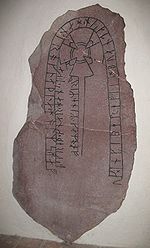 This runestone from c. 1100 is in the style RAK. It is in the wall of the porch of the church of Vallentuna. The U 215 contains the first part of the message. The stones were carved in memory of a man who drowned in Holmr's sea, but runologists are divided on the meaning of the expression. One interpretation proposed by Jansson is that it means the "Novgorodian sea" and refers to the Gulf of Finland
This runestone from c. 1100 is in the style RAK. It is in the wall of the porch of the church of Vallentuna. The U 215 contains the first part of the message. The stones were carved in memory of a man who drowned in Holmr's sea, but runologists are divided on the meaning of the expression. One interpretation proposed by Jansson is that it means the "Novgorodian sea" and refers to the Gulf of Finland
. The runestone provides the earliest Swedish attestation of an end rhyme, whereas the earliest Old Norse
attestation is Höfuðlausn
composed by Egill Skallagrímsson
.
Latin transliteration:
Old Norse transcription:
English translation:
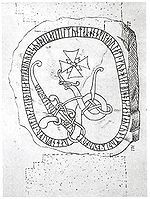 This runestone has disappeared but it was located at the church of Frösunda. It was made by the runemaster
This runestone has disappeared but it was located at the church of Frösunda. It was made by the runemaster
Åsmund Kåresson
in style Pr3-Pr4, and it was raised in memory of a man who died in Virland. It contains the same message as U 356.
Latin transliteration:
Old Norse transcription:
English translation:
Åsmund Kåresson
for a lady in memory of her son who died in Virland. It contains the same message as U 346.
Latin transliteration:
Old Norse transcription:
English translation:
.jpg) This runestone in style Fp is one of the Ingvar Runestones
This runestone in style Fp is one of the Ingvar Runestones
and due to uncertainties as to the decipherment also one of the Serkland Runestones. It was located at Steninge Palace, but it is lost. Johan Bureus, one of the first prominent Swedish runologists, visited Steninge on May 8 1595, and made a drawing of the runestone which stood by the jetty. Only 50 years later it had disappeared and in a letter written in 1645 it was explained that the stone had been used in the construction of a new stone jetty. The inscription contained an Old Norse poem
.
Latin transliteration:
Old Norse transcription:
English translation:
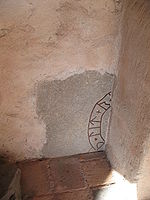 This runestone is in the wall inside the porch of the church of Roslags-Bro. It is in style Pr1, and it was raised in memory of a man who died in Virland (in Estonia
This runestone is in the wall inside the porch of the church of Roslags-Bro. It is in style Pr1, and it was raised in memory of a man who died in Virland (in Estonia
). The style shows that it was made by the runemaster
Torbjörn Skald.
Latin transliteration:
Old Norse transcription:
English translation:
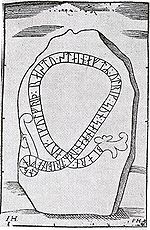 This runestone has disappeared but it was located at the church of Söderby-Karl
This runestone has disappeared but it was located at the church of Söderby-Karl
. It was possibly in style Pr1 and it commemorated a son who died in what is called Finland. At this time, Finland referred to the south-western part of what today is Finland
.
Latin transliteration:
Old Norse transcription:
English translation:
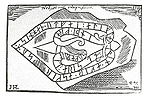 This runestone has disappeared but it was located at the church of Veckholm. It was in style Pr2-Pr3. The inscription was considered difficult to read, but it refers to a man who fell in Livonia
This runestone has disappeared but it was located at the church of Veckholm. It was in style Pr2-Pr3. The inscription was considered difficult to read, but it refers to a man who fell in Livonia
, and possibly in an expedition led by Freygeirr
.
Latin transliteration:
Old Norse transcription:
English translation:
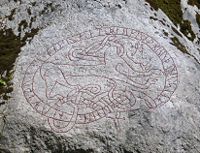 This is a runic inscription on bedrock at Åda. It is in style Pr3 and it commemorates a brother who drowned in Livonia
This is a runic inscription on bedrock at Åda. It is in style Pr3 and it commemorates a brother who drowned in Livonia
.
Latin transliteration:
Old Norse transcription:
English translation:
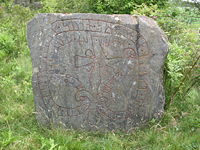 This runestone in style Fp is found in Mervalla on the island of Selaön
This runestone in style Fp is found in Mervalla on the island of Selaön
in lake Mälaren
. It is raised in memory of a man who regularly sailed a valuable knarr
to Zemgale, passing Cape Kolka
(Dómisnes). North of the Cape there is a long underwater reef which probably was infamous among the sailors of the Viking Age, and this is probably why Sigríðr wanted posterity to know that her husband had often passed it. The expression dyrum knærri ("valued cargo-ship") is an instrumental dative and it also appears in a famous stanza by the Icelander Egill Skallagrímsson
. Egill had written that his mother had promised him a fast ship so that he could sail with the Vikings and
Latin transliteration:
Old Norse transcription:
English translation:
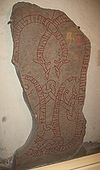 This runestone in sandstone is found in the church of the holy trinity in Gävle
This runestone in sandstone is found in the church of the holy trinity in Gävle
. It is in style Pr2 and it commemorates a brother name Egill who died in Tavastia
. Åsmund Kåresson
was one of the runemaster
s. Egill probably fell in a leidang
expedition, led by Freygeirr
who was a military leader.
Latin transliteration:
Old Norse transcription:
English translation by Sven B.F Jansson 1981:
English translation by Henrik Williams 2005:
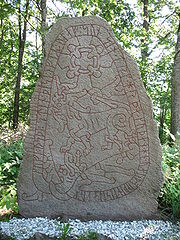 This runestone in style Pr1 is found at Frugården. It was raised in memory of a man who died in Estonia
This runestone in style Pr1 is found at Frugården. It was raised in memory of a man who died in Estonia
.
Latin transliteration:
Old Norse transcription:
English translation:
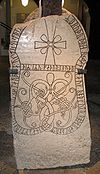 This runestone, originally located in Sjonhems, tells of the same family as G 134 and G 136, and it was made in memory of a man who died in Vindau (Ventspils
This runestone, originally located in Sjonhems, tells of the same family as G 134 and G 136, and it was made in memory of a man who died in Vindau (Ventspils
, Latvia
).
Latin transliteration:
Old Norse transcription:
English translation:
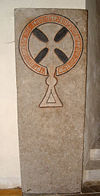 This is a late runic inscription on a grave which is dated to the early 13th century. It is located in the church of Rute and it commemorates a man who died in Finland.
This is a late runic inscription on a grave which is dated to the early 13th century. It is located in the church of Rute and it commemorates a man who died in Finland.
Latin transliteration:
Old Norse transcription:
English translation:
Varangian Runestones
The Varangian Runestones are runestones that mention voyages to the East or the Eastern route , or to more specific eastern locations such as Garðaríki ....
in memory of men who took part in peaceful or warlike expeditions across the Baltic Sea
Baltic Sea
The Baltic Sea is a brackish mediterranean sea located in Northern Europe, from 53°N to 66°N latitude and from 20°E to 26°E longitude. It is bounded by the Scandinavian Peninsula, the mainland of Europe, and the Danish islands. It drains into the Kattegat by way of the Øresund, the Great Belt and...
, where Finland
Finland
Finland , officially the Republic of Finland, is a Nordic country situated in the Fennoscandian region of Northern Europe. It is bordered by Sweden in the west, Norway in the north and Russia in the east, while Estonia lies to its south across the Gulf of Finland.Around 5.4 million people reside...
and the Baltic States
Baltic states
The term Baltic states refers to the Baltic territories which gained independence from the Russian Empire in the wake of World War I: primarily the contiguous trio of Estonia, Latvia, Lithuania ; Finland also fell within the scope of the term after initially gaining independence in the 1920s.The...
are presently located.
Beside the runestones treated in this article and in the main article Varangian runestones
Varangian Runestones
The Varangian Runestones are runestones that mention voyages to the East or the Eastern route , or to more specific eastern locations such as Garðaríki ....
, there are many other runestones that talk of eastward voyages such as the Greece runestones
Greece Runestones
The Greece runestones are about 30 runestones containing information related to voyages made by Norsemen to the Eastern Roman Empire. They were made during the Viking Age until about 1100 and were engraved in the Old Norse language with Scandinavian runes...
, Italy runestones
Italy Runestones
The Italy Runestones are three or four Varangian Runestones from 11th century Sweden that talk of warriors who died in Langbarðaland , the Old Norse name for Italy...
, and inscriptions left by the Varangian Guard
Varangian Guard
The Varangian Guard was an elite unit of the Byzantine Army in 10th to the 14th centuries, whose members served as personal bodyguards of the Byzantine Emperors....
. Other runestones that deal with Varangian expeditions include the Ingvar Runestones
Ingvar Runestones
The Ingvar Runestones is the name of c. 26 Varangian Runestones that were raised in commemoration of those who died in the Swedish Viking expedition to the Caspian Sea of Ingvar the Far-Travelled....
(erected in honor or memory of those who travelled to the Caspian Sea
Caspian Sea
The Caspian Sea is the largest enclosed body of water on Earth by area, variously classed as the world's largest lake or a full-fledged sea. The sea has a surface area of and a volume of...
with Ingvar the Far-Travelled
Ingvar the Far-Travelled
Ingvar the Far-Travelled was the leader of an unsuccessful Viking attack against Persia, in 1036–1042.There were several Caspian expeditions of the Rus' in the course of the 10th century...
). In addition, there were also voyages to Western Europe mentioned on runestones that are treated in the articles Viking runestones
Viking Runestones
The Viking Runestones are runestones that mention Scandinavians who participated in Viking expeditions. This article treats the runestone that refer to people who took part in voyages abroad, in western Europe, and stones that mention men who were Viking warriors and/or died while travelling in the...
, England runestones
England Runestones
The England runestones is a group of about 30 runestones that refer to Viking Age voyages to England. They constitute one of the largest groups of runestones that mention voyages to other countries, and they are comparable in number only to the approximately 30 Greece Runestones and the 26 Ingvar...
and Hakon Jarl runestones
Hakon Jarl Runestones
The Hakon Jarl Runestones are Swedish runestones from the time of Canute the Great.Two of the runestones, one in Uppland and one in Småland mention a Hakon Jarl, and both runologists and historians have debated whether they are one and the same, or two different men. Moreover, all known Hakon...
.
Below follows a presentation of the runestones based on the Rundata
Rundata
The Scandinavian Runic-text Data Base is a project involving the creation and maintenance of a database of runic inscriptions. The project's goal is to comprehensively catalog runestones in a machine-readable way for future research...
project. The transcriptions into Old Norse
Old Norse
Old Norse is a North Germanic language that was spoken by inhabitants of Scandinavia and inhabitants of their overseas settlements during the Viking Age, until about 1300....
are mostly in the Swedish and Danish dialect to facilitate comparison with the inscriptions, while the English translation provided by Rundata
Rundata
The Scandinavian Runic-text Data Base is a project involving the creation and maintenance of a database of runic inscriptions. The project's goal is to comprehensively catalog runestones in a machine-readable way for future research...
gives the names in the de facto standard dialect (the Icelandic and Norwegian dialect):
U 180
This runestone is possibly in style Pr4 and it is located at the church of Össeby-Garn. It was made by the runemasterRunemaster
A runemaster or runecarver is a specialist in making runestones.Most early medieval Scandinavians were probably literate in runes, and most people probably carved messages on pieces of bone and wood. However, it was difficult to make runestones, and in order to master it one also needed to be a...
Visäte
Visäte
Visäte was a runemaster who was active during the last half of the eleventh century in southern Uppland, Sweden.-Work:...
. The stone commemorates a man who either died in Viborg
Viborg, Denmark
Viborg , a town in central Jutland, Denmark, is the seat of both Viborg municipality and Region Midtjylland. Viborg is also the seat of the Western High Court, the High Court for the Jutland peninsula...
, Jutland
Jutland
Jutland , historically also called Cimbria, is the name of the peninsula that juts out in Northern Europe toward the rest of Scandinavia, forming the mainland part of Denmark. It has the North Sea to its west, Kattegat and Skagerrak to its north, the Baltic Sea to its east, and the Danish–German...
, or in Vyborg
Vyborg
Vyborg is a town in Leningrad Oblast, Russia, situated on the Karelian Isthmus near the head of the Bay of Vyborg, to the northwest of St. Petersburg and south from Russia's border with Finland, where the Saimaa Canal enters the Gulf of Finland...
, Karelia
Karelia
Karelia , the land of the Karelian peoples, is an area in Northern Europe of historical significance for Finland, Russia, and Sweden...
. Part of the inscription's text "he died in Véborg" is written on the design's cross, which may have indicated to those at home that Sigsteinn, while dying abroad, had received proper Christian burial treatment.
Latin transliteration:
- + sihatr * uk + þurbiorn + uk * þurkri(m) + uk * erinmontr '× litu × reisn + stein + aftiR + broþur + sin + sikstnin + hn to i uib(u)(r)kum
Old Norse transcription:
- Sighvatr ok Þorbiorn ok ÞorgrimR ok Ærinmundr letu ræisa stæin æftiR broður sinn Sigstæin. Hann do i Viborgum.
English translation:
- "Sighvatr and Þorbjôrn and Þorgrímr and Erinmundr had the stone raised in memory of their brother Sigsteinn. He died in Véborg."
U 214

Gulf of Finland
The Gulf of Finland is the easternmost arm of the Baltic Sea. It extends between Finland and Estonia all the way to Saint Petersburg in Russia, where the river Neva drains into it. Other major cities around the gulf include Helsinki and Tallinn...
. The runestone provides the earliest Swedish attestation of an end rhyme, whereas the earliest Old Norse
Old Norse
Old Norse is a North Germanic language that was spoken by inhabitants of Scandinavia and inhabitants of their overseas settlements during the Viking Age, until about 1300....
attestation is Höfuðlausn
Höfuðlausn
Höfuðlausn or the "Head's Ransom" is a skaldic poem attributed to Egill Skalla-Grímsson in praise of king Eirik Bloodaxe.It is cited in Egils Saga , which claims that he created it in the span of one night. The events in the saga that lead up to the composition and recitation of the poem can be...
composed by Egill Skallagrímsson
Egill Skallagrímsson
Egill Skallagrímsson was a Viking Age warrior and skald. Egill is one of the great anti-heroes of the Icelandic sagas.-Life:...
.
Latin transliteration:
- ... uk × inkiber × eftiR × buanta × sin ' han ' troknaþi ÷ a ' holms ' hafi ' skreþ ' knar ' hans ' i ' kaf þriR ' eniR ' kamo ' af
Old Norse transcription:
- ... ok Ingebærg æftiR boanda sinn. Hann drunknaði a Holms hafi, skræið knarr hans i kaf, þriR æiniR kvamu af.
English translation:
- "... and Ingibjôrg in memory of her husbandman. He drowned in Holmr's sea - his cargo-ship drifted to the sea-bottom - only three came out (alive)."
U 346

Runemaster
A runemaster or runecarver is a specialist in making runestones.Most early medieval Scandinavians were probably literate in runes, and most people probably carved messages on pieces of bone and wood. However, it was difficult to make runestones, and in order to master it one also needed to be a...
Åsmund Kåresson
Åsmund Kåresson
Åsmund Kåresson was a Viking Age runemaster who flourished during the first half of the 11th century in Uppland and Gästrikland, Sweden. The early Urnes style is represented in his art.-Work:...
in style Pr3-Pr4, and it was raised in memory of a man who died in Virland. It contains the same message as U 356.
Latin transliteration:
- [rahnfriþr * lit rt stain þino ' aftiR biurno sun þaiRa kitilmuntaR ' hon ' fil a urlati ' kuþ hialbi hons ant auk||kuþs muþiR ' osmunr mar'kaþi runaR ritar]
Old Norse transcription:
- Ragnfriðr let retta stæin þenna æftiR Biorn, sun þæiRa KætilmundaR. Hann fell a Virlandi. Guð hialpi hans and ok Guðs moðiR. Asmundr markaði runaR rettaR.
English translation:
- "Ragnfríðr had this stone erected in memory of Bjôrn, her son and Ketilmundr's. He fell in Virland. May God and God's mother help his spirit. Ásmundr marked the right runes."
U 356
This runestone in style Pr3 is located in Ängby. It was made by the runemasterRunemaster
A runemaster or runecarver is a specialist in making runestones.Most early medieval Scandinavians were probably literate in runes, and most people probably carved messages on pieces of bone and wood. However, it was difficult to make runestones, and in order to master it one also needed to be a...
Åsmund Kåresson
Åsmund Kåresson
Åsmund Kåresson was a Viking Age runemaster who flourished during the first half of the 11th century in Uppland and Gästrikland, Sweden. The early Urnes style is represented in his art.-Work:...
for a lady in memory of her son who died in Virland. It contains the same message as U 346.
Latin transliteration:
- ra(h)nfriþr ' lit rasa stain þino ' aftiR biurn * sun þaiRa * kitilmun(t)aR ' kuþ mialbi hons (a)nt auk| |kuþs (m)uþiR hon fil a uirlanti * in osmuntr markaþi
Old Norse transcription:
- Ragnfriðr let ræisa stæin þenna æftiR Biorn, sun þæiRa KætilmundaR. Guð hialpi hans and ok Guðs moðiR. Hann fell a Virlandi. En Asmundr markaði.
English translation:
- "Ragnfríðr had this stone raised in memory of Bjôrn, her son and Ketilmundr's. May God and God's mother help his spirit. He fell in Virland. And Ásmundr marked."
U 439
.jpg)
Ingvar Runestones
The Ingvar Runestones is the name of c. 26 Varangian Runestones that were raised in commemoration of those who died in the Swedish Viking expedition to the Caspian Sea of Ingvar the Far-Travelled....
and due to uncertainties as to the decipherment also one of the Serkland Runestones. It was located at Steninge Palace, but it is lost. Johan Bureus, one of the first prominent Swedish runologists, visited Steninge on May 8 1595, and made a drawing of the runestone which stood by the jetty. Only 50 years later it had disappeared and in a letter written in 1645 it was explained that the stone had been used in the construction of a new stone jetty. The inscription contained an Old Norse poem
Old Norse poetry
Old Norse poetry encompasses a range of verse forms written in Old Norse, during the period from the 8th century to as late as the far end of the 13th century...
.
Latin transliteration:
- [harlaif × auk × þurkarþr × litu × raisa × stain × þina at × sabi faþur sin × is||sturþi × austr × skibi × maþ ikuari a/a| |askalat-/skalat-]
Old Norse transcription:
- Hærlæif ok Þorgærðr letu ræisa stæin þenna at Sæbiorn, faður sinn. Es styrði austr skipi með Ingvari a Æistaland(?)/Særkland[i](?).
English translation:
- "Herleif and Þorgerðr had this stone raised in memory of Sæbjôrn, their father, who steered a ship east with Ingvarr to Estonia(?)/Serkland(?)."
U 533

Estonia
Estonia , officially the Republic of Estonia , is a state in the Baltic region of Northern Europe. It is bordered to the north by the Gulf of Finland, to the west by the Baltic Sea, to the south by Latvia , and to the east by Lake Peipsi and the Russian Federation . Across the Baltic Sea lies...
). The style shows that it was made by the runemaster
Runemaster
A runemaster or runecarver is a specialist in making runestones.Most early medieval Scandinavians were probably literate in runes, and most people probably carved messages on pieces of bone and wood. However, it was difficult to make runestones, and in order to master it one also needed to be a...
Torbjörn Skald.
Latin transliteration:
-
* sigruþ * lit + raisa * stain * eftir + anunt * sun * sin * han uas ' tribin + a + uirlanti
Old Norse transcription:
- Sigruð let ræisa stæin æftiR Anund, sun sinn. Hann vas drepinn a Virlandi.
English translation:
- "Sigþrúðr had the stone raised in memory of Ônundr, her son. He was killed in Virland."
U 582

Söderby-Karl
Söderby-Karl is a locality situated in Norrtälje Municipality, Stockholm County, Sweden with 217 inhabitants in 2005....
. It was possibly in style Pr1 and it commemorated a son who died in what is called Finland. At this time, Finland referred to the south-western part of what today is Finland
Finland
Finland , officially the Republic of Finland, is a Nordic country situated in the Fennoscandian region of Northern Europe. It is bordered by Sweden in the west, Norway in the north and Russia in the east, while Estonia lies to its south across the Gulf of Finland.Around 5.4 million people reside...
.
Latin transliteration:
- [biarn huk * ikulfriþ : raistu : stain : aftR : utrik : sun : sain * han * uaR : tribin : o * fin*lonti]
Old Norse transcription:
- Biorn ok Igulfrið ræistu stæin æftiR Otrygg, sun sinn. Hann vaR drepinn a Finnlandi.
English translation:
- "Bjôrn and Ígulfríðr raised the stone in memory of Ótryggr, their son. He was killed in Finland."
U 698

Livonia
Livonia is a historic region along the eastern shores of the Baltic Sea. It was once the land of the Finnic Livonians inhabiting the principal ancient Livonian County Metsepole with its center at Turaida...
, and possibly in an expedition led by Freygeirr
Freygeirr
Freygeirr was a Viking chieftain who probably led a leidang expedition. He is considered to have been active in the 1050s on the Baltic coast, and he has been identified on six runestones, Gs 13, DR 216, U 518, U 611, U 698 and U 1158.On the runestone Gs 13, Freygeirr is reported to be the leader...
.
Latin transliteration:
- P [sufar lit : aristn * þin * afir * askir sun : sin : han * ut fai : a liflai|n|þ|i| |i| |i|n|þ|i * frai...]
- Q [sufar lit : aristn * þin * afir * askir sun : sin : han * ut fai : a liflai|n|þ| i| |i|n|þ|i * frai...]
Old Norse transcription:
- P
let ræisa stæin æftiR AsgæiR, sun sinn. Hann uti fioll a Liflandi i liði Frøy[gæiRs](?). - Q
let ræisa stæin æftiR AsgæiR, sun sinn. Hann ut fioll a Lifland i liði Frøy[gæiRs](?).
English translation:
- "
had the stone raised in memory of Ásgeirr, his son. He fell in Lífland, abroad in Freygeirr's(?) retinue."
Sö 39

Livonia
Livonia is a historic region along the eastern shores of the Baltic Sea. It was once the land of the Finnic Livonians inhabiting the principal ancient Livonian County Metsepole with its center at Turaida...
.
Latin transliteration:
-
: hermoþr : lit : hagua : at : barkuiþ : bruþur : sin : h[an] trukn-þi : [a] lf:lanti :
Old Norse transcription:
- Hærmoðr let haggva at Bergvið/Barkvið, broður sinn. Hann drunkn[a]ði a Liflandi.
English translation:
- "Hermóðr had (the rock) cut in memory of Bergviðr/Barkviðr, his brother. He drowned in Lífland."
Sö 198

Selaön
Selaön is the largest island in Mälaren, Sweden, and covers 91 km². It is located at Stallarholmen, east of Strängnäs, and it has about 3,000 permanent residents. It is connected by a bridge to the mainland. It is the largest island in any lake in Sweden....
in lake Mälaren
Mälaren
Lake Mälaren is the third-largest lake in Sweden, after Lakes Vänern and Vättern. Its area is 1,140 km² and its greatest depth is 64 m. Mälaren spans 120 kilometers from east to west...
. It is raised in memory of a man who regularly sailed a valuable knarr
Knarr
The Knarr is a Bermuda rigged, long keeled, sailing yacht designed in 1943 by Norwegian Erling L. Kristofersen. Knarrer were traditionally built in wood, with the hull upside down on a fixed frame, then attaching the iron keel after the hull was completed. The hull planks were manufactured with...
to Zemgale, passing Cape Kolka
Cape Kolka
Cape Kolka - cape on the Baltic Sea, near the entry to Gulf of Riga, in Livonian coast, in the Courland historical region of Latvia. The cape is surrounded by the Irbe Strait which serves as the natural border with Estonia. Cape Kolka represents the southwestern limit of the Gulf of Riga.Cape...
(Dómisnes). North of the Cape there is a long underwater reef which probably was infamous among the sailors of the Viking Age, and this is probably why Sigríðr wanted posterity to know that her husband had often passed it. The expression dyrum knærri ("valued cargo-ship") is an instrumental dative and it also appears in a famous stanza by the Icelander Egill Skallagrímsson
Egill Skallagrímsson
Egill Skallagrímsson was a Viking Age warrior and skald. Egill is one of the great anti-heroes of the Icelandic sagas.-Life:...
. Egill had written that his mother had promised him a fast ship so that he could sail with the Vikings and
|
|
Latin transliteration:
- siriþ * lit * resa * stan * [þin](a) [*] (a)(t) * suen * sin * [b]unta * h[n] * uft * siklt * til * simk(a)(l)(a) * t(u)ru[m] * knari * um * tumisnis
Old Norse transcription:
- Sigrið let ræisa stæin þenna at Svæin, sinn bonda. Hann oft siglt til Sæimgala, dyrum knærri, um Domisnæs.
English translation:
- "Sigríðr had this stone raised in memory of Sveinn, her husbandman. He often sailed a valued cargo-ship to Seimgalir, around Dómisnes."
Gs 13

Gävle
Gävle is a city in Sweden, the seat of Gävle Municipality and the capital of Gävleborg County. It had 71,033 inhabitants in 12/31 2010. It is the oldest city in the historical Norrland , having received its charter in 1446 from Christopher of Bavaria.-History:It is believed that the name Gävle...
. It is in style Pr2 and it commemorates a brother name Egill who died in Tavastia
Tavastia (historical province)
Tavastia, Tavastland or Häme, Russian Emi or Yemi, is a historical province in the south of Finland. It borders Finland Proper, Satakunta, Ostrobothnia, Savonia and Uusimaa.- Administration :...
. Åsmund Kåresson
Åsmund Kåresson
Åsmund Kåresson was a Viking Age runemaster who flourished during the first half of the 11th century in Uppland and Gästrikland, Sweden. The early Urnes style is represented in his art.-Work:...
was one of the runemaster
Runemaster
A runemaster or runecarver is a specialist in making runestones.Most early medieval Scandinavians were probably literate in runes, and most people probably carved messages on pieces of bone and wood. However, it was difficult to make runestones, and in order to master it one also needed to be a...
s. Egill probably fell in a leidang
Leidang
The institution known as leiðangr , leidang , leding, , ledung , expeditio or sometimes lething , was a public levy of free farmers typical for medieval Scandinavians. It was a form of conscription to organise coastal fleets for seasonal excursions and in defence of the realm...
expedition, led by Freygeirr
Freygeirr
Freygeirr was a Viking chieftain who probably led a leidang expedition. He is considered to have been active in the 1050s on the Baltic coast, and he has been identified on six runestones, Gs 13, DR 216, U 518, U 611, U 698 and U 1158.On the runestone Gs 13, Freygeirr is reported to be the leader...
who was a military leader.
Latin transliteration:
- × brusi lit rita s-... ... [(a)]b--R (i)h(i)(l) brur sin : in h-n uarþ tauþr a tafstalonti × þo brusi furþi lank lans ' abtiR [br](u)r sin h(o)[n] fur (m)iR fraukiRi kuþ hialbi hons| |salu| |uk| |kuþ(s) (m)(u)[þiR ' suain ' uk osmunrt ' þaiR markaþu] +
Old Norse transcription:
- Brusi let retta s[tæin þenna] æf[ti]R Ægil, broður sinn. En h[a]nn varð dauðr a Tafæistalandi, þa Brusi førði læiðang(?) lands æftiR broður sinn. Hann for meðr FrøygæiRi. Guð hialpi hans salu ok Guðs moðiR. Svæinn ok Asmundr þæiR markaðu.
English translation by Sven B.F Jansson 1981:
- "Brúsi had this stone erected in memory of Egill, his brother. And he died in Tafeistaland, when Brúsi brought (= led?) the land's levy(?) (= army) in memory of , his brother. He travelled with FreygeirrFreygeirrFreygeirr was a Viking chieftain who probably led a leidang expedition. He is considered to have been active in the 1050s on the Baltic coast, and he has been identified on six runestones, Gs 13, DR 216, U 518, U 611, U 698 and U 1158.On the runestone Gs 13, Freygeirr is reported to be the leader...
. May God and God's mother help his soul. Sveinn and Ásmundr, they marked."
English translation by Henrik Williams 2005:
- "Brúsi had this stone erected in memory of Egill, his brother. And he died in Tafeistaland, when Brúsi bore long-spear (=battle standard) after his brother. He travelled with FreygeirrFreygeirrFreygeirr was a Viking chieftain who probably led a leidang expedition. He is considered to have been active in the 1050s on the Baltic coast, and he has been identified on six runestones, Gs 13, DR 216, U 518, U 611, U 698 and U 1158.On the runestone Gs 13, Freygeirr is reported to be the leader...
. May God and God's mother help his soul. Sveinn and Ásmundr, they marked."
Vg 181

Estonia
Estonia , officially the Republic of Estonia , is a state in the Baltic region of Northern Europe. It is bordered to the north by the Gulf of Finland, to the west by the Baltic Sea, to the south by Latvia , and to the east by Lake Peipsi and the Russian Federation . Across the Baltic Sea lies...
.
Latin transliteration:
- kufi : rsþi : stin : þesi : eftR : ulaf : sun : sin * trk * hrþa * kuþan * hn * uarþ * trbin * i * estlatum * hu(a)rþ(r) * iuk * s---
Old Norse transcription:
- Gufi ræisti stæin þennsi æftiR Olaf, sun sinn, dræng harða goðan. Hann varð drepinn i Æistlandum. Havarðr(?) hiogg s[tæin].
English translation:
- "Gufi raised this stone in memory of Ólafr, his son, a very good valiant man. He was killed in Estonia. Hávarðr(?) cut the stone."
G 135

Ventspils
Ventspils is a city in northwestern Latvia in the Courland historical region of Latvia, the sixth largest city in the country. As of 2006, Ventspils had a population of 43,806. Ventspils is situated on the Venta River and the Baltic Sea, and has an ice-free port...
, Latvia
Latvia
Latvia , officially the Republic of Latvia , is a country in the Baltic region of Northern Europe. It is bordered to the north by Estonia , to the south by Lithuania , to the east by the Russian Federation , to the southeast by Belarus and shares maritime borders to the west with Sweden...
).
Latin transliteration:
- þina : eftir : a(i)--- : --- : --rþ : tauþr : a : ui(t)au : systriR : [tuaR] ...-R : bryþr : þria : roþanþr : auk : roþkutr : roþar : auk : þorstain : þiR : iRu : faþur:bryþr
Old Norse transcription:
- Þenna æftiR Æi... ... [va]rð dauðr a Vindau/Vindö. SystriR tvaR ... brøðr þria. Hroðvaldr(?) ok Hroðgautr, Hroðarr ok Þorstæinn, þæiR eRu faðurbrøðr.
English translation:
- "This (one) in memory of Ei-... (who) died at Vindey/Vindö. Two sisters ... three brothers. Hróðvaldr(?) and Hróðgautr, Hróðarr and Þorsteinn, they are the father's brothers."
G 319

Latin transliteration:
- si[h]tris : aruar[r] : litu : giera : st[a]en : yfir : auþu-l- : broþur : sin : a : finlandi : do : aglia...
Old Norse transcription:
- Sigtryggs(?) arfaR letu gæra stæinn yfiR Auðv[a]l[d](?), broður sinn, a Finnlandi do
.
English translation:
- "Sigtryggr's(?) heirs had the stone made over Auðvaldr(?), their brother, who died in Finland ..."
Sources
- Jansson, Sven B. F. (1980). Runstenar. STF, Stockholm. ISBN 91-7156-015-7
- Peterson, Lena. Nordisk Runnamnslexikon Swedish Institute for Linguistics and Heritage (Institutet för språk och folkminnen).
- Pritsak, Omeljan. (1981). The Origin of Rus. Cambridge, Mass.: Distributed by Harvard University Press for the Harvard Ukrainian Research Institute. ISBN 0-674-64465-4
- Project Samnordisk Runtextdatabas Svensk - RundataRundataThe Scandinavian Runic-text Data Base is a project involving the creation and maintenance of a database of runic inscriptions. The project's goal is to comprehensively catalog runestones in a machine-readable way for future research...
- Williams, Henrik. (2005). Vittnat runstenen från Söderby (Gs 13) om Sveriges första ledungståg? Runfilologi och konsten att läsa som det står. ISSN 0349-0416
External links
- An English Dictionary of Runic Inscriptions of the Younger Futhark, at the University of Nottingham

